Shinsaku Sakaue
Non-Stationary Online Structured Prediction with Surrogate Losses
Oct 08, 2025Abstract:Online structured prediction, including online classification as a special case, is the task of sequentially predicting labels from input features. Therein the surrogate regret -- the cumulative excess of the target loss (e.g., 0-1 loss) over the surrogate loss (e.g., logistic loss) of the fixed best estimator -- has gained attention, particularly because it often admits a finite bound independent of the time horizon $T$. However, such guarantees break down in non-stationary environments, where every fixed estimator may incur the surrogate loss growing linearly with $T$. We address this by proving a bound of the form $F_T + C(1 + P_T)$ on the cumulative target loss, where $F_T$ is the cumulative surrogate loss of any comparator sequence, $P_T$ is its path length, and $C > 0$ is some constant. This bound depends on $T$ only through $F_T$ and $P_T$, often yielding much stronger guarantees in non-stationary environments. Our core idea is to synthesize the dynamic regret bound of the online gradient descent (OGD) with the technique of exploiting the surrogate gap. Our analysis also sheds light on a new Polyak-style learning rate for OGD, which systematically offers target-loss guarantees and exhibits promising empirical performance. We further extend our approach to a broader class of problems via the convolutional Fenchel--Young loss. Finally, we prove a lower bound showing that the dependence on $F_T$ and $P_T$ is tight.
Bandit and Delayed Feedback in Online Structured Prediction
Feb 26, 2025Abstract:Online structured prediction is a task of sequentially predicting outputs with complex structures based on inputs and past observations, encompassing online classification. Recent studies showed that in the full information setup, we can achieve finite bounds on the surrogate regret, i.e., the extra target loss relative to the best possible surrogate loss. In practice, however, full information feedback is often unrealistic as it requires immediate access to the whole structure of complex outputs. Motivated by this, we propose algorithms that work with less demanding feedback, bandit and delayed feedback. For the bandit setting, using a standard inverse-weighted gradient estimator, we achieve a surrogate regret bound of $O(\sqrt{KT})$ for the time horizon $T$ and the size of the output set $K$. However, $K$ can be extremely large when outputs are highly complex, making this result less desirable. To address this, we propose an algorithm that achieves a surrogate regret bound of $O(T^{2/3})$, which is independent of $K$. This is enabled with a carefully designed pseudo-inverse matrix estimator. Furthermore, for the delayed full information feedback setup, we obtain a surrogate regret bound of $O(D^{2/3} T^{1/3})$ for the delay time $D$. We also provide algorithms for the delayed bandit feedback setup. Finally, we numerically evaluate the performance of the proposed algorithms in online classification with bandit feedback.
Any-stepsize Gradient Descent for Separable Data under Fenchel--Young Losses
Feb 07, 2025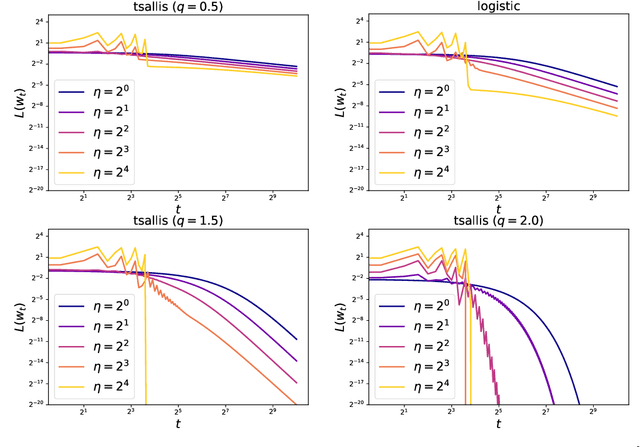
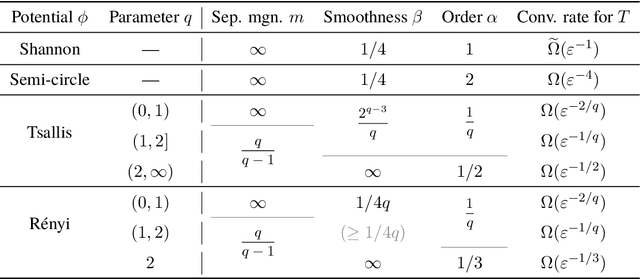


Abstract:The gradient descent (GD) has been one of the most common optimizer in machine learning. In particular, the loss landscape of a neural network is typically sharpened during the initial phase of training, making the training dynamics hover on the edge of stability. This is beyond our standard understanding of GD convergence in the stable regime where arbitrarily chosen stepsize is sufficiently smaller than the edge of stability. Recently, Wu et al. (COLT2024) have showed that GD converges with arbitrary stepsize under linearly separable logistic regression. Although their analysis hinges on the self-bounding property of the logistic loss, which seems to be a cornerstone to establish a modified descent lemma, our pilot study shows that other loss functions without the self-bounding property can make GD converge with arbitrary stepsize. To further understand what property of a loss function matters in GD, we aim to show arbitrary-stepsize GD convergence for a general loss function based on the framework of \emph{Fenchel--Young losses}. We essentially leverage the classical perceptron argument to derive the convergence rate for achieving $\epsilon$-optimal loss, which is possible for a majority of Fenchel--Young losses. Among typical loss functions, the Tsallis entropy achieves the GD convergence rate $T=\Omega(\epsilon^{-1/2})$, and the R{\'e}nyi entropy achieves the far better rate $T=\Omega(\epsilon^{-1/3})$. We argue that these better rate is possible because of \emph{separation margin} of loss functions, instead of the self-bounding property.
Online Inverse Linear Optimization: Improved Regret Bound, Robustness to Suboptimality, and Toward Tight Regret Analysis
Jan 27, 2025
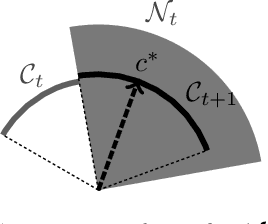
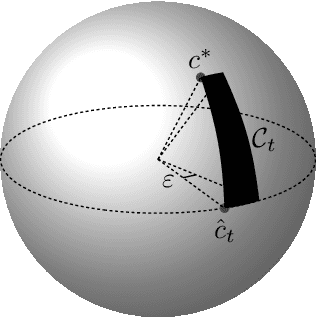
Abstract:We study an online learning problem where, over $T$ rounds, a learner observes both time-varying sets of feasible actions and an agent's optimal actions, selected by solving linear optimization over the feasible actions. The learner sequentially makes predictions of the agent's underlying linear objective function, and their quality is measured by the regret, the cumulative gap between optimal objective values and those achieved by following the learner's predictions. A seminal work by B\"armann et al. (ICML 2017) showed that online learning methods can be applied to this problem to achieve regret bounds of $O(\sqrt{T})$. Recently, Besbes et al. (COLT 2021, Oper. Res. 2023) significantly improved the result by achieving an $O(n^4\ln T)$ regret bound, where $n$ is the dimension of the ambient space of objective vectors. Their method, based on the ellipsoid method, runs in polynomial time but is inefficient for large $n$ and $T$. In this paper, we obtain an $O(n\ln T)$ regret bound, improving upon the previous bound of $O(n^4\ln T)$ by a factor of $n^3$. Our method is simple and efficient: we apply the online Newton step (ONS) to appropriate exp-concave loss functions. Moreover, for the case where the agent's actions are possibly suboptimal, we establish an $O(n\ln T+\sqrt{\Delta_Tn\ln T})$ regret bound, where $\Delta_T$ is the cumulative suboptimality of the agent's actions. This bound is achieved by using MetaGrad, which runs ONS with $\Theta(\ln T)$ different learning rates in parallel. We also provide a simple instance that implies an $\Omega(n)$ lower bound, showing that our $O(n\ln T)$ bound is tight up to an $O(\ln T)$ factor. This gives rise to a natural question: can the $O(\ln T)$ factor in the upper bound be removed? For the special case of $n=2$, we show that an $O(1)$ regret bound is possible, while we delineate challenges in extending this result to higher dimensions.
Revisiting Online Learning Approach to Inverse Linear Optimization: A Fenchel$-$Young Loss Perspective and Gap-Dependent Regret Analysis
Jan 24, 2025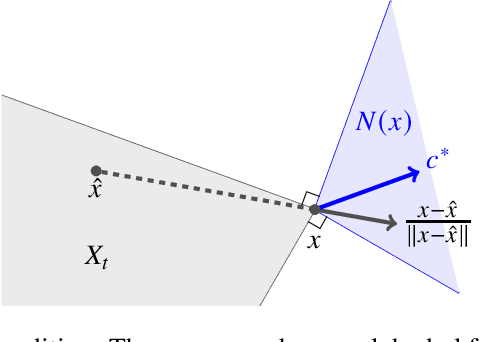
Abstract:This paper revisits the online learning approach to inverse linear optimization studied by B\"armann et al. (2017), where the goal is to infer an unknown linear objective function of an agent from sequential observations of the agent's input-output pairs. First, we provide a simple understanding of the online learning approach through its connection to online convex optimization of \emph{Fenchel--Young losses}. As a byproduct, we present an offline guarantee on the \emph{suboptimality loss}, which measures how well predicted objectives explain the agent's choices, without assuming the optimality of the agent's choices. Second, assuming that there is a gap between optimal and suboptimal objective values in the agent's decision problems, we obtain an upper bound independent of the time horizon $T$ on the sum of suboptimality and \emph{estimate losses}, where the latter measures the quality of solutions recommended by predicted objectives. Interestingly, our gap-dependent analysis achieves a faster rate than the standard $O(\sqrt{T})$ regret bound by exploiting structures specific to inverse linear optimization, even though neither the loss functions nor their domains enjoy desirable properties, such as strong convexity.
No-Regret M${}^{ atural}$-Concave Function Maximization: Stochastic Bandit Algorithms and NP-Hardness of Adversarial Full-Information Setting
May 21, 2024Abstract:M${}^{\natural}$-concave functions, a.k.a. gross substitute valuation functions, play a fundamental role in many fields, including discrete mathematics and economics. In practice, perfect knowledge of M${}^{\natural}$-concave functions is often unavailable a priori, and we can optimize them only interactively based on some feedback. Motivated by such situations, we study online M${}^{\natural}$-concave function maximization problems, which are interactive versions of the problem studied by Murota and Shioura (1999). For the stochastic bandit setting, we present $O(T^{-1/2})$-simple regret and $O(T^{2/3})$-regret algorithms under $T$ times access to unbiased noisy value oracles of M${}^{\natural}$-concave functions. A key to proving these results is the robustness of the greedy algorithm to local errors in M${}^{\natural}$-concave function maximization, which is one of our main technical results. While we obtain those positive results for the stochastic setting, another main result of our work is an impossibility in the adversarial setting. We prove that, even with full-information feedback, no algorithms that run in polynomial time per round can achieve $O(T^{1-c})$ regret for any constant $c > 0$ unless $\mathsf{P} = \mathsf{NP}$. Our proof is based on a reduction from the matroid intersection problem for three matroids, which would be a novel idea in the context of online learning.
Online Structured Prediction with Fenchel--Young Losses and Improved Surrogate Regret for Online Multiclass Classification with Logistic Loss
Feb 13, 2024Abstract:This paper studies online structured prediction with full-information feedback. For online multiclass classification, van der Hoeven (2020) has obtained surrogate regret bounds independent of the time horizon, or \emph{finite}, by introducing an elegant \emph{exploit-the-surrogate-gap} framework. However, this framework has been limited to multiclass classification primarily because it relies on a classification-specific procedure for converting estimated scores to outputs. We extend the exploit-the-surrogate-gap framework to online structured prediction with \emph{Fenchel--Young losses}, a large family of surrogate losses including the logistic loss for multiclass classification, obtaining finite surrogate regret bounds in various structured prediction problems. To this end, we propose and analyze \emph{randomized decoding}, which converts estimated scores to general structured outputs. Moreover, by applying our decoding to online multiclass classification with the logistic loss, we obtain a surrogate regret bound of $O(B^2)$, where $B$ is the $\ell_2$-diameter of the domain. This bound is tight up to logarithmic factors and improves the previous bound of $O(dB^2)$ due to van der Hoeven (2020) by a factor of $d$, the number of classes.
Data-Driven Projection for Reducing Dimensionality of Linear Programs: Generalization Bound and Learning Methods
Sep 01, 2023Abstract:This paper studies a simple data-driven approach to high-dimensional linear programs (LPs). Given data of past $n$-dimensional LPs, we learn an $n\times k$ \textit{projection matrix} ($n > k$), which reduces the dimensionality from $n$ to $k$. Then, we address future LP instances by solving $k$-dimensional LPs and recovering $n$-dimensional solutions by multiplying the projection matrix. This idea is compatible with any user-preferred LP solvers, hence a versatile approach to faster LP solving. One natural question is: how much data is sufficient to ensure the recovered solutions' quality? We address this question based on the idea of \textit{data-driven algorithm design}, which relates the amount of data sufficient for generalization guarantees to the \textit{pseudo-dimension} of performance metrics. We present an $\tilde{\mathrm{O}}(nk^2)$ upper bound on the pseudo-dimension ($\tilde{\mathrm{O}}$ compresses logarithmic factors) and complement it by an $\Omega(nk)$ lower bound, hence tight up to an $\tilde{\mathrm{O}}(k)$ factor. On the practical side, we study two natural methods for learning projection matrices: PCA- and gradient-based methods. While the former is simple and efficient, the latter sometimes leads to better solution quality. Experiments confirm that learned projection matrices are beneficial for reducing the time for solving LPs while maintaining high solution quality.
Faster Discrete Convex Function Minimization with Predictions: The M-Convex Case
Jun 09, 2023Abstract:Recent years have seen a growing interest in accelerating optimization algorithms with machine-learned predictions. Sakaue and Oki (NeurIPS 2022) have developed a general framework that warm-starts the L-convex function minimization method with predictions, revealing the idea's usefulness for various discrete optimization problems. In this paper, we present a framework for using predictions to accelerate M-convex function minimization, thus complementing previous research and extending the range of discrete optimization algorithms that can benefit from predictions. Our framework is particularly effective for an important subclass called laminar convex minimization, which appears in many operations research applications. Our methods can improve time complexity bounds upon the best worst-case results by using predictions and even have potential to go beyond a lower-bound result.
Rethinking Warm-Starts with Predictions: Learning Predictions Close to Sets of Optimal Solutions for Faster $\text{L}$-/$\text{L}^ atural$-Convex Function Minimization
Feb 02, 2023Abstract:An emerging line of work has shown that machine-learned predictions are useful to warm-start algorithms for discrete optimization problems, such as bipartite matching. Previous studies have shown time complexity bounds proportional to some distance between a prediction and an optimal solution, which we can approximately minimize by learning predictions from past optimal solutions. However, such guarantees may not be meaningful when multiple optimal solutions exist. Indeed, the dual problem of bipartite matching and, more generally, $\text{L}$-/$\text{L}^\natural$-convex function minimization have arbitrarily many optimal solutions, making such prediction-dependent bounds arbitrarily large. To resolve this theoretically critical issue, we present a new warm-start-with-prediction framework for $\text{L}$-/$\text{L}^\natural$-convex function minimization. Our framework offers time complexity bounds proportional to the distance between a prediction and the set of all optimal solutions. The main technical difficulty lies in learning predictions that are provably close to sets of all optimal solutions, for which we present an online-gradient-descent-based method. We thus give the first polynomial-time learnability of predictions that can provably warm-start algorithms regardless of multiple optimal solutions.
 Add to Chrome
Add to Chrome Add to Firefox
Add to Firefox Add to Edge
Add to Edge